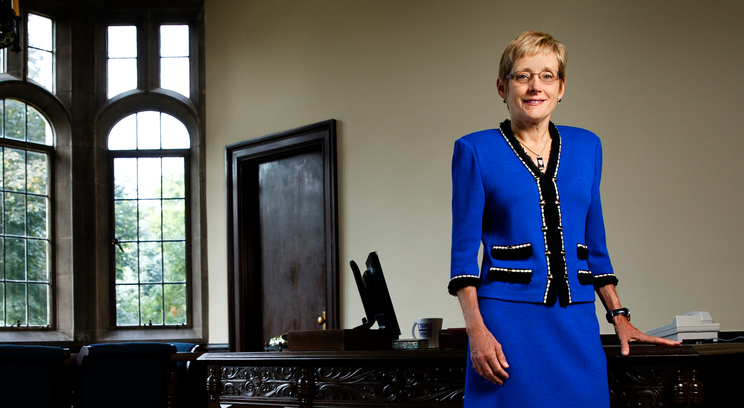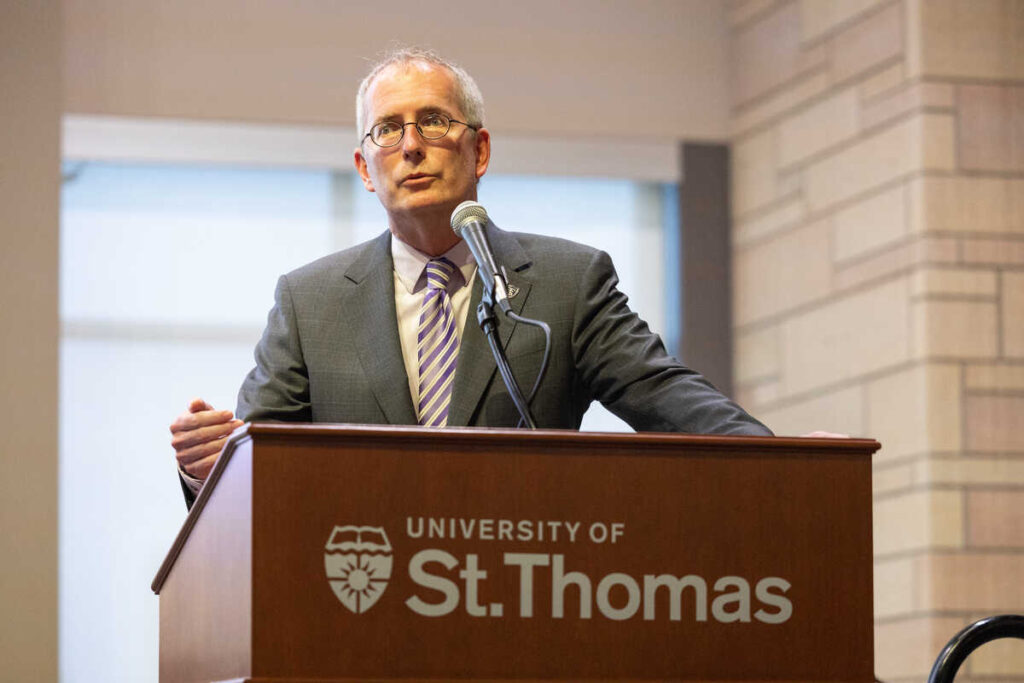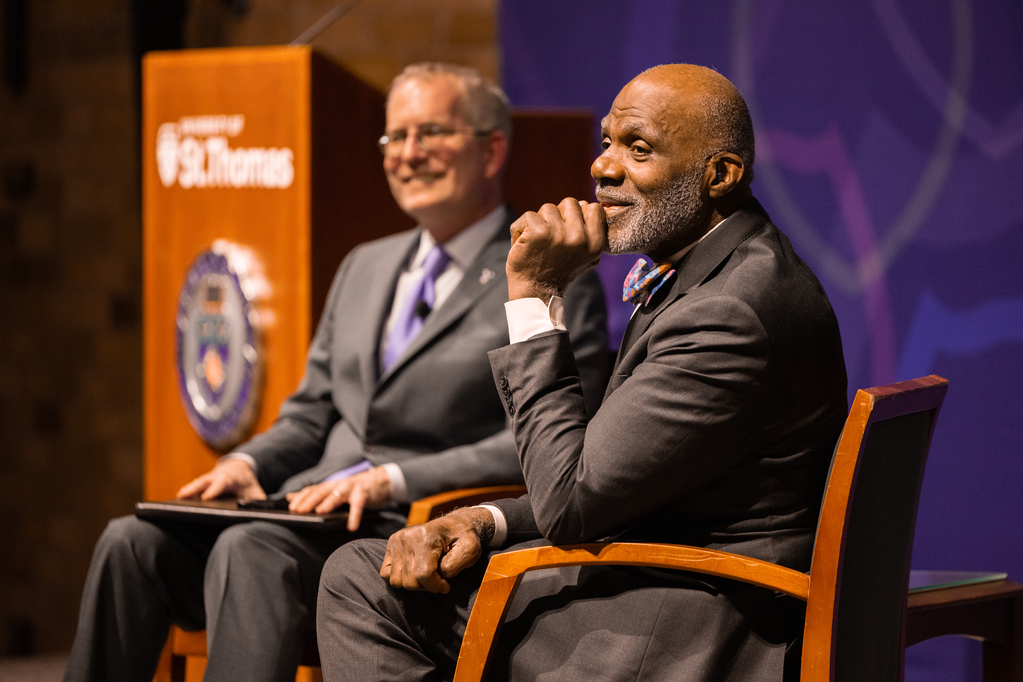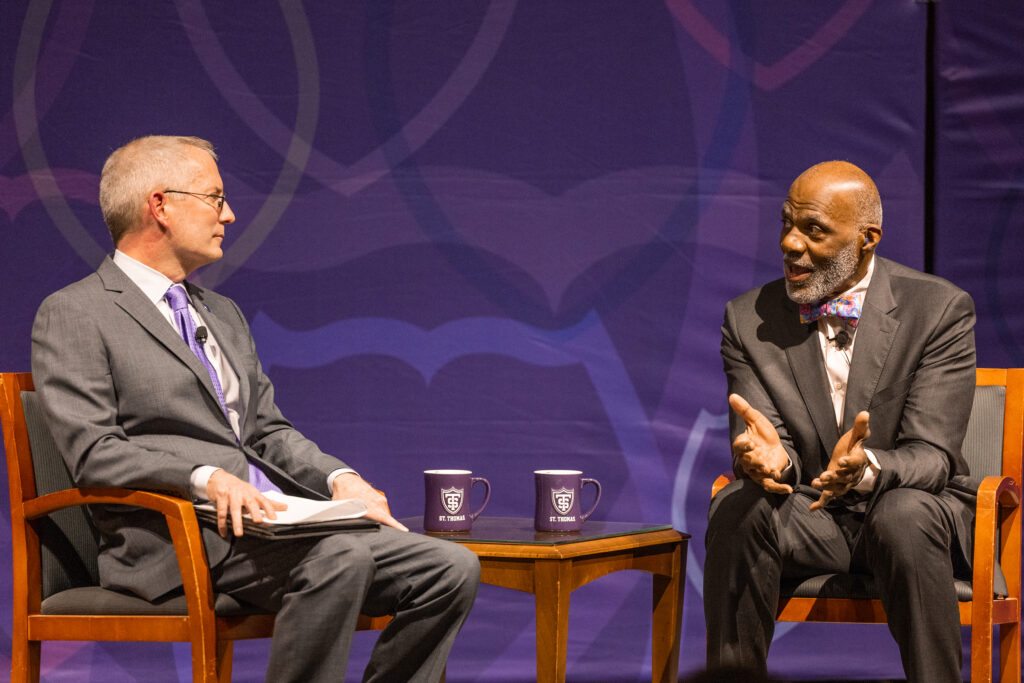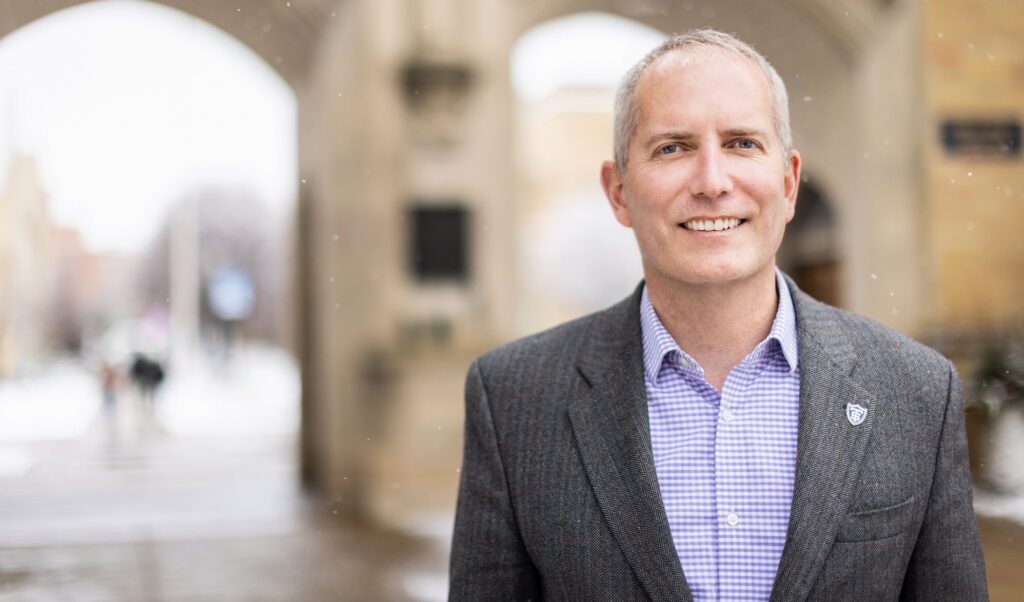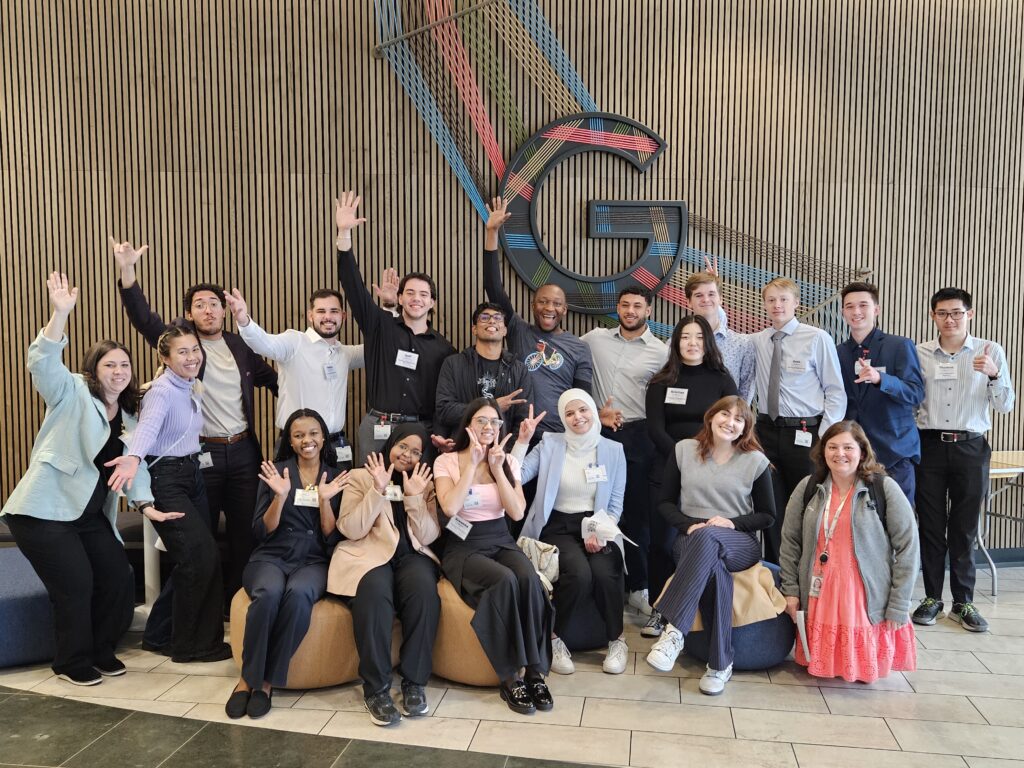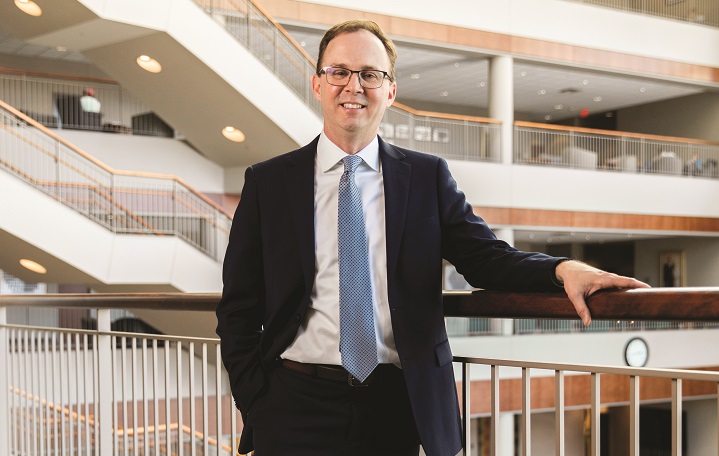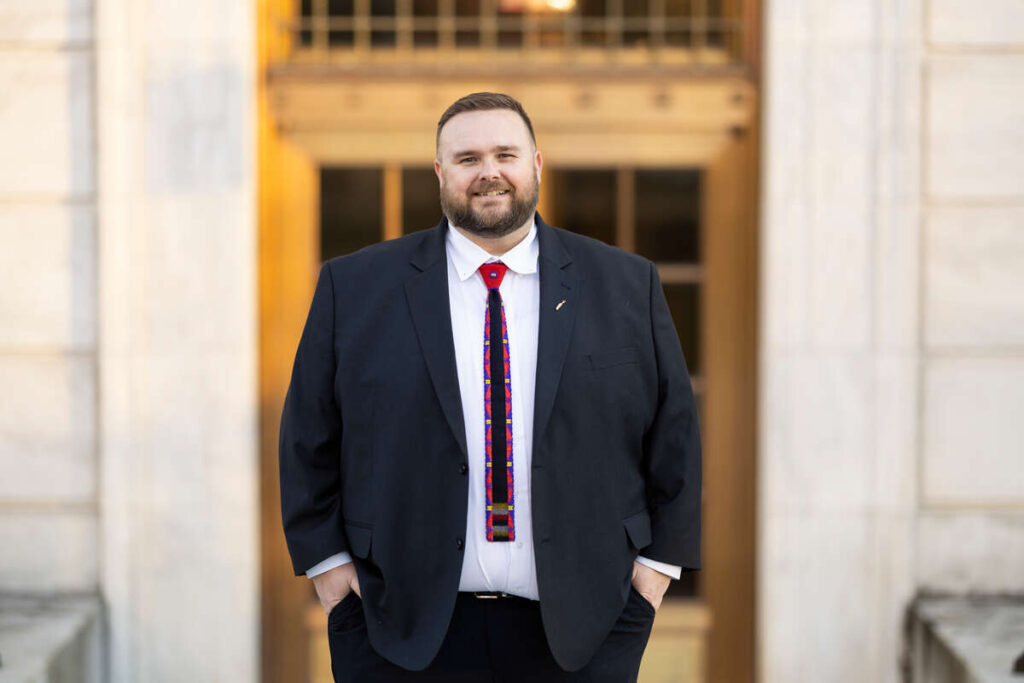Academic excellence, Catholic identity and mission, and organizational culture were the themes addressed Monday by Dr. Julie Sullivan in her first academic convocation address as president of St. Thomas.
Sullivan chose the themes after reviewing comments made by more than 3,100 faculty, staff and students in response to a planning survey she distributed last spring.
“I will share what I have learned from you about our strengths and opportunities,” she told the convocation audience in O’Shaughnessy Educational Center auditorium. “As an academic community of almost 12,000 individuals, I have been amazed at the strong consensus (which is not exactly what academic communities are known for) and the power this gives us to move forward together.”
Sullivan later spoke about how the St. Thomas community will use “a guiding star – our vision” – as a catalyst to develop goals and specific initiatives.
“Beginning this fall, we will engage in an inclusive, campus-wide discussion and strategic planning process,” she said. “So, as I close this afternoon, let me say the journey has begun, and I commit to you that it will be an exciting and fulfilling journey.”
Here is the complete text of Sullivan’s remarks:
Good afternoon!
And welcome to the 2013-14 academic year at the University of St. Thomas.
I cannot adequately express how excited I am to begin my adventure with you, particularly today, as we celebrate the launching of a new year. It has been a long wait with many important milestones.
I have felt extraordinarily welcomed at St. Thomas from the outset of my journey, which began last fall when I was contacted by the search committee charged with recommending a successor to Father Dease. The journey continued through interviews and meetings with the committee and other trustee, faculty, and administrative leaders.
I knew I had truly “arrived” at St. Thomas when I entered the Hearth Room in the Anderson Student Center on February 14, for a news conference after the Board of Trustees elected me as your president. Among those who greeted me was Tommie, our lovable and always-cheerful mascot. He – she? – had that big grin on her – his? – face, and both of us reacted instinctively. We high-fived each other!
It was an indelible moment, and not because the high-five photo made the front page of the Star Tribune. The memory has remained with me because it characterizes the genuine spirit of openness, hospitality and generosity you have extended to me over the last six and one-half months.
Acknowledgement of Father Dease
I want to acknowledge our very special friend and colleague: Father Dennis Dease. Take it from someone who watched the growth and evolution of St. Thomas from afar for a long time: what Father Dease and you accomplished during his 22 years as president of this university was absolutely astonishing, and he deserves our gratitude and our praise. He has been – and I know will continue to be – an invaluable friend and advisor to me and a wonderful St. Thomas colleague to all of us. Father Dease, we thank you.
The Past 200 Days
I would like to devote most of my remarks today to what I have learned from and about you since that memorable first high five with Tommie. Today is the 201st day since February 14. During the past 200 days, I made several multi-day visits to St. Thomas, read the results of the climate survey and the Higher Learning Commission (HLC) self-study, and commissioned and pored over the results of a planning survey (more about that in a moment). I have been in-residence on campus since July 25 (almost six weeks) and during that time I have engaged in a lively and stimulating 1.5 day retreat with 22 individuals from the university’s leadership team (including all of our deans) and have had enlightening discussions with the Senate Executive Committee and past chairs of the Faculty, the African American and Asian faculty and staff affinity groups, the Provost Search Committee, and the leaders of the College of Arts and Sciences strategic positioning project, among others. And I soon will be meeting with our Hispanic/Latino affinity group (ENLACE), the Ad Hoc Allies Committee, the faculty of each of the Colleges and Schools, and the staff from many departments.
My thanks to each of you who has so generously and candidly shared your pride in and hopes for our university.
Now more about the planning survey. Shortly after I was elected president, I convened several colleagues (Dr. Mike Cogan, Dr. Peter Parilla, Sara Gross-Methner and Doug Hennes) to develop a brief planning survey that would give me a clear sense of the following:
- No. 1: What does our community view as the most important strengths that distinguish St. Thomas?
- No. 2: What new initiatives or opportunities would you like to pursue over the next five years? and
- No. 3: If you could change one thing about St. Thomas, what would it be, and why?
When the survey closed after a month, 3,142 people had responded and on average each devoted 30 minutes to sharing their feedback. In sum, you offered 446,000 words, which Dr. Cogan pointed out is 80 percent the length of “War and Peace,” and I read all of your responses! Response rates were 84 percent for full-time faculty, 75 percent for staff, 24 percent for undergraduate students, 20 percent for graduate students, and 36 percent for adjunct faculty. These are astounding numbers and they tell me two things: you are engaged and truly care about the future of this university, and you want to be a part of creating that future.
A summary of the planning survey’s findings will be published later this week in the St. Thomas Newsroom.
I would like to organize the insights I have gleaned about St. Thomas from all of these sources and interactions into three broad categories: academic excellence, Catholic identity and mission, and organizational culture. Within each category I will share what I have learned from you about our strengths and our opportunities. As an academic community of almost 12,000 individuals, I have been amazed at the strong consensus (which is not exactly what academic communities are known for) and the power this gives us to move forward together.
Academic Excellence
Hands down, the number one thing I hear and read is your pride in our academic and educational excellence. Faculty, staff and students uniformly agree the world-class quality of our faculty and the learning experiences you provide are our greatest strength. You are described as “committed,” “dedicated,” “engaged,” “talented,” “caring,” and “passionate.” Students speak gratefully about your accessibility and the personal relationships they develop with you. They appreciate our small class sizes and how this facilitates active student-to-student and student-to-faculty interactions. The growth and quality of faculty/student research and other out-of-class collaborations also is seen as a strength.
We cherish our commitment to holistic education and to the liberal arts. We appreciate the connection between liberal arts and professional education and are proud to be considered a comprehensive university centered in the liberal arts.
While there remains some variance on this point, we appreciate balanced expectations of faculty between teaching and research, with the understanding that we will never sacrifice quality teaching.
Finally, we enjoy a strong reputation for academic excellence regionally that can be built upon and extended to also encompass national and international recognition and visibility.
In turning to our opportunities to enhance that excellence, you speak frequently about the need for a stronger and clearer academic vision and for our academic mission to occupy the central role in our planning and decision-making. There was specific mention of the “provost model” and this feedback was influential on the new organizational structure I announced on July 1 and will continue to influence the job description for the next provost who will succeed Dr. Huber. This input also influenced my decision to create a President’s Cabinet that includes our provost, vice presidents, academic deans and other campus leaders.
There was extensive input from all St. Thomas constituents regarding a desire to increase the diversity and inclusiveness of our community. While I will return to this topic in the next theme, I raise it now because in my view increased diversity among our students, faculty, and staff enriches the learning experience we provide. I use the term diversity in its broadest sense: race/ethnicity, gender, sexual orientation, geographic (both domestic and international), religious, and socioeconomic. Students want and need to learn side by side with students from all facets of life, knowing that this increasingly will be the case in their personal and professional lives. Students value difference and recognize the enhanced understanding that occurs when different backgrounds, lenses, and perspectives are brought to the discussion.
All of our constituents express the need to refresh our curriculum and programs - to eliminate programs of lesser quality or relevance and to launch new programs that are responsive to current and emerging educational needs of our society. There is a recognition that such needs likely will best be met with multidisciplinary programs that are connected to the community and incorporate experiential learning whenever possible. Thus, there is a desire to further incorporate into our teaching and learning our vibrant urban location with major industries such as healthcare, energy, and food and many impactful social service, religious, arts, and cultural organizations.
Finally, we all appreciate the mandate to be more flexible, adaptable, and accountable in delivering the highest quality learning experience in the most affordable manner. There is a desire to assess, clarify, and extend our hybrid and on-line forms of delivery. Faculty, in particular, express a desire for more opportunities to learn about and experiment with alternative forms of delivery. Students, particularly graduate students, appreciate the flexibility offered by our hybrid and on-line experiences and encourage us to do more.
There also is a recognition that achieving our aspiration of ensuring access to every talented student, regardless of economic means, will require imagination and adaptability that extends far beyond alternative modes of delivery.
Catholic Identity and Mission
The community consistently expresses a strong appreciation of the integration of our Catholic identity throughout the institution and recognizes this as a key strength of our university. In describing this strength, you speak about your appreciation of Catholic intellectual tradition, our Catholic heritage, our dedication to social justice, and our pursuit of the integration of faith and reason.
Our mission statement, especially how we educate “morally responsible leaders….to advance the common good” is referenced frequently. You also speak of our community involvement, civic-mindedness, and service orientation. Finally, discussions of our commitment to the liberal arts and to the holistic education of our students is often related to our strong Catholic identity and mission.
In the survey responses, all groups frequently referred to our Catholic identity and mission as a strength and also as an opportunity. Many expressed a general desire for St. Thomas to strengthen, grow, and deepen our Catholic identity and mission. However, there were few specific suggestions as to how to do this. There also were hints that there may not be widespread consensus if such suggestions were offered.
So, how do we strengthen our Catholic identity and mission? How do we ensure our Catholic identity and mission have the greatest impact and relevance in the world we live in today and anticipate for tomorrow? This obviously is a broad discussion that we must take time to engage in together, but I will offer some preliminary thoughts today by talking briefly about three areas where we expect our Catholic identity and mission to be impactful and thus areas to explore for opportunities to strengthen it.
First, our Catholic identity and mission should be reflected in our curriculum. As a Catholic university we seek to ensure our students debate and explore the ultimate questions of human existence. We expect our students to appreciate a greater purpose and mission in life beyond their own existence and to explore and strengthen their own morals and values. We expect students to grasp the contributions of Catholic intellectual tradition and the principles of Catholic social thought to many disciplines beyond theology and philosophy.
Are we doing this as effectively as possible in our curriculum? For example, a significant number of undergraduate students responding to the planning survey suggested that the number of required philosophy and theology courses be decreased. Can we do a better job articulating for ourselves and our students the relevance and value of these courses, while continuing our work to explicitly link them to courses in other disciplines? Are there further opportunities for other disciplines, where appropriate, to connect to Catholic intellectual tradition and the principles of Catholic social thought? I am not the one to answer these questions, but I think this is an important dialogue for our faculty.
Secondly, our Catholic identity and mission call us to recognize and respect the dignity of every human person as a child of God and as created in God’s image. Thus, we have a Catholic mission-based calling to embrace and treat every person in our community with love and support. Based on the results of last year’s campus climate survey, as compared to the 2007 results, we are doing a better job of creating and nurturing a welcoming and inclusive university. However, our standard - that every person in our community feels welcomed and included - is very high. We must continually strive to achieve it. I was reminded of this a week ago Sunday when I attended Mass at a primarily Hispanic parish in Minneapolis. After Mass, a very sincere father approached me and thanked me for being there. He also shared a sad story of the unwelcoming feeling his son had recently when visiting St. Thomas as a prospective student.
The planning and climate surveys reflected concern about a welcoming and supportive attitude to lesbian, gay, bisexual, and transgender persons in our community. It pains me to think that a gay student, staff or faculty member would ever feel unwelcome or a need to “hide” at St. Thomas. As Pope Francis reminds us, we are not called to judge. We are called to love and support everyone in our community regardless of their sexual orientation. And, I might add, regardless of the gender of their spouse.
Thirdly, our Catholic identity and mission include a passionate commitment to social justice, solidarity, and advancing the common good. In fulfilling that mission, we are called to take action and to become leaders of sustainable changes and solutions that improve the human condition, that provide access and opportunity for all, and that cherish the natural resources of our planet. We recognize that we cannot create change for others, but rather we must work with others to create innovative and sustainable approaches to improving lives and communities.
Are we providing our students the learning experiences and the skills, attitudes, and spiritual commitment to make the greatest difference in our world? What more can we do to develop our students’ empathy, mindfulness, self-reflection, comfort with ambiguity, imagination and optimism?
Organizational Culture
The third area referenced frequently in the planning survey and my discussions with you is organizational culture. You consistently describe your relationships with others at St. Thomas as collegial, warm and family-like. It is evident that people here love St. Thomas, care about one another, and demonstrate their care – and you should be proud of that.
Yet, the organization seems to be at an important point in its lifecycle of development. We once were one college. As we grew and became a comprehensive university, we naturally developed different academic units, as well as separate academic and administrative structures. As one would expect it became more difficult to maintain relationships and communication, and silos developed.
Our opportunity today is to eliminate the silos and strengthen the culture of one university. One university, one family, and one mission. As an educational institution, we are here to facilitate learning and discovery (discovery of new knowledge; discovery about ourselves, our values, and convictions; and discovery about others and our world). Each one of us contributes to this mission, whether we are a faculty member or play some other role. Thus, our new organizational structure seeks to eliminate classifying people as academic or administrative. We all further our fundamental mission of learning and discovery.
Along these same lines, you consistently point to the need for greater communication and collaboration and the trust it engenders. You want more frequent and open communication and you want our leaders, starting with me, to share information as issues are considered and decisions are made.
This input influenced my decision to establish a fairly large and broadly representative President’s Cabinet that will meet monthly to discuss university issues. It also sparked our plan to hold several brown bags per semester, beginning this fall, for discussion of specific university issues and topics.
Finally, you want to refresh our bold, entrepreneurial, and risk-taking spirit. You want the institution as a whole to embrace change and opportunity. You don’t want to offer an idea and hear in response, “We have never done it that way before,” or “We always do it this way.” I can assure you that you will never hear these responses from me. For one reason, I wouldn’t know if we have or haven’t always done it this or that way. On the other hand, I hope I don’t drive you crazy with my continual questions about why we do certain things the way we do. I believe in the old adage that “You should never tear down a wall before you understand why it was built.”
Conclusion
So, it has been a very enlightening 200 days. As I have peeled back the layers of the onion, I have become even more excited and enthused about my new life at St. Thomas and my role as your president. This is a great university and you are fabulous people, and together we can take St. Thomas to new levels of impact, relevance, and recognition. So, how do we chart this path? We can no longer be poised. We need to start our journey. Where do we begin?
First, we need a guiding star – our vision. As a community, we will further develop and articulate that vision. Then, we will determine our goals for realizing this vision and the specific initiatives (with timelines and measurable outcomes) to achieve our goals. Beginning this fall, we will engage in an inclusive, campus wide discussion and strategic planning process to develop these.
So, as I close this afternoon, let me say the journey has begun, and I commit to you that it will be an exciting and fulfilling journey.
